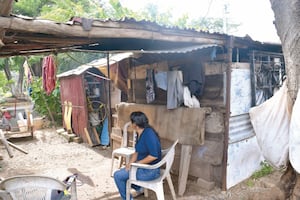Más Información

Marco Rubio destaca labor de seguridad de México; "están haciendo más que nunca en su historia", afirma

Sin garras y con lesiones Profepa rescata a león amarrado a un árbol en Nayarit; inician investigación

Inegi oficializa creación de nueva instancia para medir la pobreza, tras desaparición del Coneval; crea una Dirección General

Juez frena revocación de testigo protegido a Raúl Rocha; da medida cautelar a dueño de Miss Universo
During the period January 2008 to April 2019, in most days, the Mexico City metropolitan area showed a level of PM2.5 and PM10 suspended particles that was above the maximum recommended by the World Health Organization (WHO) . By said standards, Mexico City has had a poor air quality five out of every seven days since 2008.
PM10 particles (often described as coarse particles) are smaller than 10 micrometers (0.01 mm) in diameter. Due to their relatively large size, they don’t remain in the air for too long.
Common sources of PM10 particles include sea salt, pollen and combustion activities such as motor vehicles and industrial processes. Dust from unsealed roads is a major source of PM10 particles.
High levels of PM10 particles in the air can irritate the eyes and throat. People with existing heart or lung conditions (including asthma) can experience an increase in symptoms, including wheezing, chest tightness and difficulty breathing.
On the other hand, PM2.5 particles are small enough to be breathed deep into the lungs. They result from the burning of fossil fuels (such as coal), organic matter (including wood and grass) and most other materials, such as rubber and plastic. Motor vehicles, power plant emissions and bushfires are all major sources of fine particles.
An analysis conducted by EL UNIVERSAL with information from the Mexico City Atmospheric Monitoring Directorate indicated that in 3,212 days (77% of the total), at least one air monitoring station had detected PM10 pollution levels that exceeded the maximum recommended by the WHO, which is of 50 micrograms per cubic meter. As per PM2.5 particles, for which the WHO’s standard limit is of 25 micrograms, monitoring stations detected exceeding levels in 2,746 out of all 4,138 days in the time span considered (66% of days).
Moreover, a total of 20 environmental contingencies were declared in Mexico City between 2008 and 2019. However, all of them were registered after 2016: 16 were due to ozone levels and only four were due to PM10 particles.
In order for an environmental contingency to be declared in Mexico City, PM10 and PM2.5 particles must reach levels of 214 and 97.4 µg/m³ each, which is four times as much as the standard limit set by the WHO.
According to Doctor Guillermo Guidos Fogelbach , an academic and allergology specialist from the National Polytechnic Institute (IPN) , the health effects of high amounts of PM10 and PM2.5 particles in the air may vary depending on a person’s health history and age. Children and older adults are most vulnerable to this type of pollution, as well as patients with heart or lung problems.
These adverse air conditions also make it more likely for citizens to develop heart and lung problems throughout their lives.
In order to determine the consequences of high pollution levels for citizens, Fátima Masse , author of several scientific articles regarding air pollution at the Mexican Institute for Competitiveness, conducted a study in 2016 based on a formula issued by the World Health Organization.
“ Bad air quality is not listed officially as a cause of death ,” she stated “so we calculated the amount of natural deaths—due to respiratory and cardiovascular causes, as well as some types of cancer—associated with bad air quality in Mexico City.”
Her team found a total of 1,823 premature deaths, more than 4,494 hospitalizations, and more than 247,729 medical examinations that resulted from air pollution in 2015. Economically, the experts estimated that these health issues had represented a cost of around MXN$1.6 billion in hospital expenses and declines in productivity.
According to the National Institute of Ecology and Climate Change , as well as the National Public Health Institute , a total of 9,767 deaths could have been avoided in Mexico City and surrounding areas if the city’s PM2.5 levels had not exceeded WHO standards. Another 12,089 deaths could have been avoided if PM10 pollution levels had not exceeded the limit.
The standards set by the World Health Organization “are more restrictive than Mexican standards, which set the limit at 75µg/m³ for PM10 particles and 45µg/m³ for PM2.5 particles,” stated Sergio Zirath Hernández, head of Mexico City’s General Air Quality Directorate .
He claimed that his organization was working to create a new program to improve air quality in the city from 2021 to 2030. “There’s not much science to it, we’ll just learn about what other countries are doing to fix this type of problem and try to suggest better policies for the handling of air pollution,” he commented.
However, he warned that any actions and policies applied in Mexico City to tackle the issue should also be applied in the State of Mexico and other surrounding regions.
“We need to ensure coordination with other state and municipal governments and work to implement more aggressive policies in terms of transport. There is still a lot to be done,” he concluded.
dm
Noticias según tus intereses
[Publicidad]
[Publicidad]











